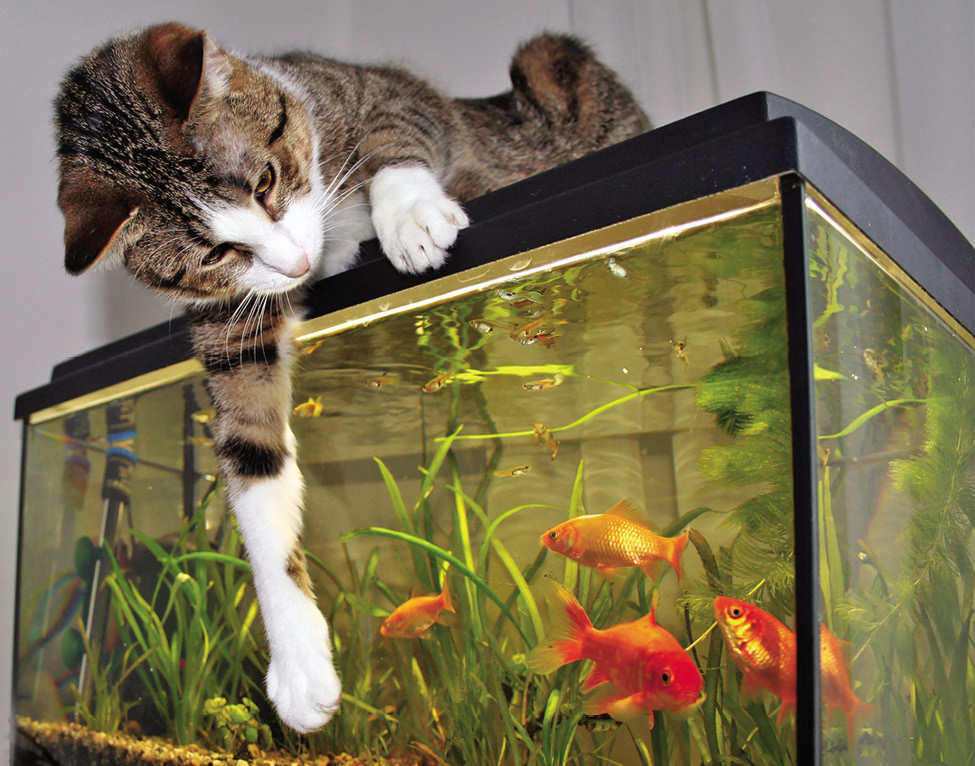Cats are hunters, born and bred. Even as tiny kittens who can barely stand, they practice stalking and pouncing behaviors. These traits have served the feline species well over the millennia and make them excellent pest-control officers. But these same killer instincts are less than ideal if you are fond of your pet birds.
Keeping a natural predator in the house with his perfect prey has many inherent risks, and we can’t promise any miracles, says Katherine Houpt, VMD, PhD, professor emeritus of behavior at Cornell University’s College of Veterinary Medicine. If you’re considering this combination of animal residents, the best strategies for protecting your small pets are, “Sturdy cages, closed doors!” says Dr. Houpt.
Pet or Prey
Depending on your cat’s preferences, small animals might pique his interest as a snack. If you have or are considering adding any of these animals as pets, you need to make a cat protection plan:
- Canaries
- Finches
- Fish
- Frogs and Toads
- Gerbils
- Guinea pigs
- Hamsters
- Reptiles
- Lovebirds and other small parrots
- Mice
- Parakeets
- Rats
Larger pets such as chickens, rabbits, and even tiny dogs may also trigger some cats’ hunting instincts. Always monitor your cat around a new pet of any species and watch closely for signs of predatory behavior, such as an intense stare, dilated pupils, stalking, or charging. And never assume that just because they’ve lived together for a few months, that instinct is no longer an issue. It is.
Closed Doors
The best way to keep your small pets safe from your cat is to prevent access to them. Even if your cat seems content to just watch the prey animals and doesn’t try to attack them, her scent and presence alone can be stressful. After all, one of the keys to survival for rodents and birds is recognizing when a predator is near and taking cover.
A closed door is the most secure barrier to keep your cat away from prey animals. Keeping your birds, fish, rodents, reptiles, and amphibians in their own room away from the cat is the best insurance (of course, other family members need to be educated on the importance of keeping that door closed).
If your cat isn’t too intense about the smaller animals, you may be able to let her be near them under supervision. For example, you might allow your cat into your home office where your finches live while you are working. However, closing the door when you leave is the best way to be sure that she doesn’t act differently when your back is turned.
Other ways to keep your cat away are to use tall baby gates in doorways or put decorative fencing around the enclosure. Be sure that your cat can’t jump or climb the barrier.
Simple “booby traps,” such as a stack of plastic cups or a compressed air cannister hooked up to a motion sensor, strategically placed around a tank or cage may help to train your cat to stay away. That said, there is always a risk that your cat will go around or become accustomed to the trap and still choose to harm your other pet.
Sturdy Cages
Any prey animal living in a house with a cat should have a sturdy cage that is difficult for the cat to break into. Even if you keep your cat separate from your snack-sized pets, mistakes happen, and it is nice to have a second layer of security.
Features to look for in a new tank or cage or potentially add to an existing one include:
Locking doors. Many bird cages have guillotine-type doors that are simply lifted up, an easy feat for a cat. Choose cages that have some sort of latch on all doors or use twist ties to fasten them closed when you are not actively caring for your birds.
Difficult to tip. Tall, narrow cages for birds and small rodents often appeal to us because they give our pocket-pets lots of room to explore while only taking up a small amount of floor space. But that tall narrow construction compromises the security of the cage, especially if it is made of a lightweight material. Make sure your cat can’t tip the cage over if she jumps on it or whacks it with a paw as she tries to strike one of the inhabitants.
Hefty lid. Cats are great jumpers, especially when motivated. Consider whether the cage can support your cat’s weight from above. Double check that lids on aquariums and terrariums have a latch, so that your cat can’t lift them up and duck in. And if your aquarium has no cover at all, add one immediately.
Narrow bars. Many small mammals and birds require half-inch bar spacing anyway, but narrow bars are necessary to prevent your cat from reaching into the cage to harass its inhabitants.
Foster Appropriate Hunting
In addition to physical security measures, you can help protect your smaller pets by ensuring that your cat is getting plenty of mental and physical stimulation. A bored feline might choose to entertain himself by testing how to eat your pet mouse, but a tired feline is more likely to settle in for a nap. Engage your cat in hunting-style play with wand toys, rolling balls, and treat-dispensing toys.
Hunting is an integral part of being a cat, so giving him an appropriate outlet with toys will both make him feel happier and more content while also protecting your prey animal pets.




